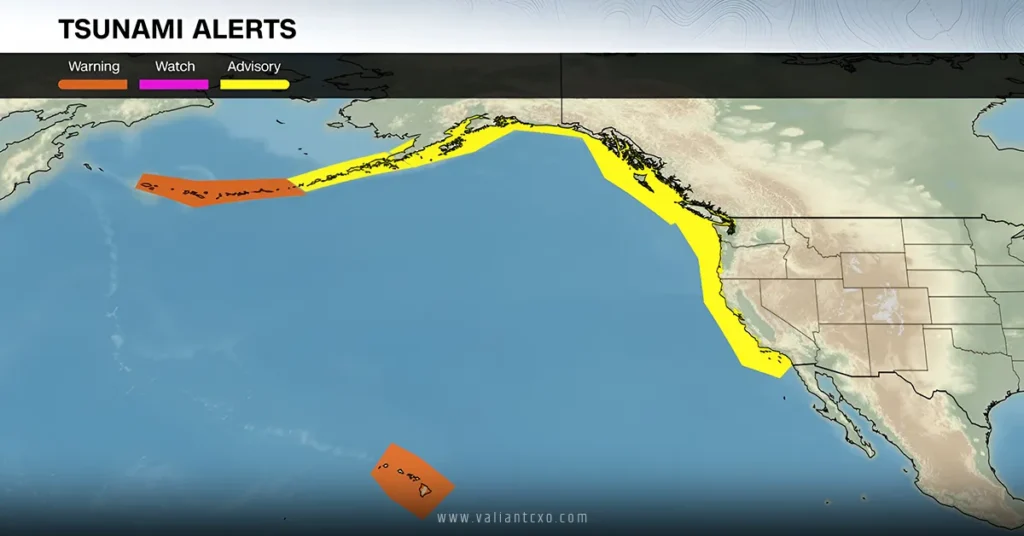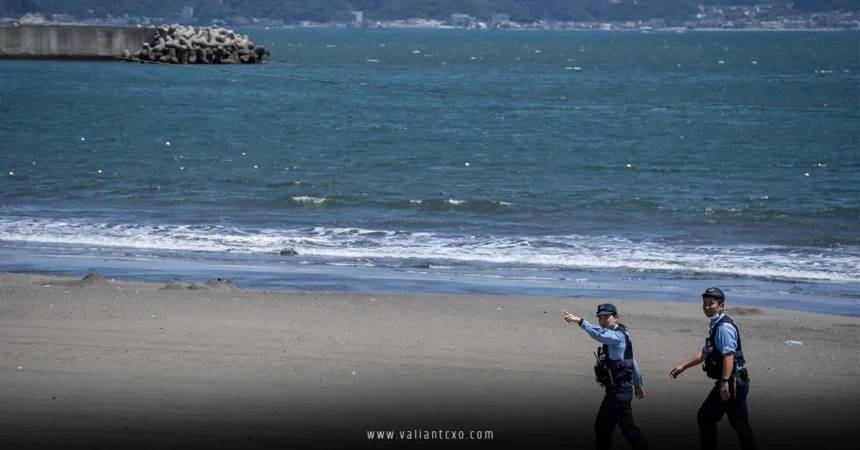A Pacific-Wide Tsunami Threat
Tsunami Warnings : On July 30, 2025, a historic 8.8-magnitude earthquake struck off Russia’s Kamchatka Peninsula, one of the strongest quakes ever recorded, triggering widespread tsunami warnings across the Pacific, including the US, Japan, China, and the Philippines. With waves up to 4 meters already hitting Russia and Japan, and evacuations underway in Hawaii, California, and beyond, this event echoes devastating tsunamis like Japan’s 2011 disaster. For U.S. audiences, the threat to Hawaii, Alaska, and the West Coast demands urgent attention. This article covers the latest tsunami warnings, regional impacts, and safety measures, with a nod to global context like Curaçao’s recent smuggling concerns.
Latest Tsunami Warning Updates (July 30, 2025)
Tsunami Warnings : A shallow 8.8-magnitude earthquake struck 119 km southeast of Petropavlovsk-Kamchatsky, Russia, at a depth of 19.3 km, sparking tsunami alerts across the Pacific. Here’s the latest by region, based on reports from Al Jazeera, CNN, BBC, and others:
- United States
- Hawaii: A tsunami warning is in effect for all islands, with waves up to 3 meters (10 feet) possible. A 1.2-meter (4-foot) wave hit Oahu, and a 1-meter wave was recorded at Midway Atoll. Governor Josh Green warned of “significant damage” as waves could wrap around islands, urging evacuations to high ground or the fourth floor of buildings. Harbors are closed, and flights to Maui are canceled.
- Alaska: A tsunami warning covers the Aleutian Islands, with a watch for the broader coastline. Waves of 1–3 meters are possible.
- West Coast: California’s northern coast (Cape Mendocino to Oregon) is under a tsunami warning due to its unique underwater geography, which could amplify waves up to 5 feet. Advisories cover southern California, Oregon, and Washington, urging residents to avoid beaches. Los Angeles Mayor Karen Bass noted waves under 1 foot are expected but urged preparedness.
- Japan
- Tsunami waves of 0.3–1.3 meters have hit Hokkaido, Iwate, and Tokachi, with forecasts of up to 3 meters. Nearly 2 million people across 220 municipalities are under evacuation orders, with residents moving to rooftops or hills. The Fukushima nuclear plant, hit by a 2011 tsunami, has 4,000 workers sheltering safely, with no irregularities reported. Prime Minister Shigeru Ishiba warned of larger secondary waves, urging prolonged vigilance.
- China
- A yellow alert (moderate threat) warns of waves up to 1 meter along the eastern seaboard, including Shanghai and Zhejiang. Combined with Tropical Storm Co-May’s landfall in Zhoushan, larger storm surges are feared. Coastal evacuations are underway.
- Philippines
- The Philippine Institute of Volcanology and Seismology (PHIVOLCS) issued advisories for eastern coastal provinces, expecting waves under 1 meter. No major threat is anticipated, but classes in Davao Occidental and Digos City are suspended, and residents are urged to avoid beaches.
- Russia
- Waves of 3–4 meters flooded Severo-Kurilsk, Sakhalin, damaging a fish processing plant and sweeping away boats. Nearly 300 residents were evacuated, and a state of emergency was declared. Minor injuries were reported, with a kindergarten damaged but no fatalities. Aftershocks of 6.3 and 6.9 magnitudes followed.
- Other Regions
- Alerts cover Ecuador (Galapagos Islands), Peru, Chile, Mexico, Indonesia, Taiwan, Guam, and New Zealand, with waves of 0.3–3 meters possible. New Zealand warns of “strong and unusual currents” along its coasts.
Tsunami Warnings : Context and Connection to Global Events
Tsunami Warnings : The earthquake’s epicenter in the Pacific Ring of Fire, a seismically active zone, explains its far-reaching impact, similar to the 2011 Japan (9.0) and 2004 Sumatra (9.1) quakes. Kamchatka’s history of strong quakes (e.g., 9.0 in 1952) underscores its risk. Meanwhile, Curaçao’s July 2025 tarantula smuggling incident (320 tarantulas seized in Peru, destined for Curaçao) highlights vulnerabilities in global trade routes, which could extend to disaster-related supply chains, like emergency aid or satellite tech for tsunami monitoring. While unrelated, it emphasizes the need for secure logistics during crises.

Implications for U.S. Audiences
- Safety Risks: Tsunami Warnings : Hawaii faces the highest risk, with potential for $7.5 million in damages (similar to 2011). Coastal flooding, strong currents, and debris pose threats. California’s northern coast could see amplified waves due to underwater geography.
- Economic Impact: Tsunami Warnings : Harbor closures and flight cancellations in Hawaii disrupt tourism and trade. Damage to infrastructure (e.g., Russia’s fish plant) could affect Pacific supply chains, indirectly impacting U.S. markets.
- Preparedness Lessons: Tsunami Warnings : Upgraded evacuation maps and sirens in Hawaii show progress since 2011, but gridlocked roads (e.g., Waikiki) highlight challenges. U.S. residents must follow local guidance and avoid coastlines.
Safety Measures for U.S. Residents
- Hawaii: Evacuate to high ground or the fourth floor of sturdy buildings. Avoid beaches, harbors, and coastal roads. Check evacuation zones at tsunami.gov or Hawaii EMA.
- West Coast: Stay away from shores, especially in northern California. Follow National Weather Service alerts and local officials.
- General Tips: Monitor tsunami.gov, enable emergency alerts on phones, and prepare go-bags with essentials. Use Google AI Mode to query “tsunami safety tips for Hawaii” for real-time guidance.
- Long-Term: Support seismic research (e.g., USGS) and coastal resilience programs to mitigate future risks.
Conclusion: Staying Safe Amid the Tsunami Threat
Tsunami Warnings : The 8.8-magnitude earthquake off Russia’s Kamchatka Peninsula on July 30, 2025, has unleashed a Pacific-wide tsunami threat, with waves impacting Russia, Japan, and Hawaii, and alerts spanning the US, China, and the Philippines. U.S. residents, especially in Hawaii and California, must prioritize evacuation and monitor tsunami.gov. Global events like Curaçao’s smuggling case remind us of the need for secure systems in crises. Stay informed, follow local guidance.
For More Updates!! : valiantcxo.com


